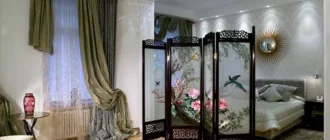Shabby chic is an interior design style that makes extensive use of antique or artificially aged pieces of furniture and decor. Shabby chic skillfully combines features of other traditional styles, as well as special grace and simplicity of furnishing.
It is a very difficult style to implement in the interior. Designers have to put in a lot of effort to keep the atmosphere in the room not shabby and old-fashioned, but charmingly romantic and cozy. This style is especially popular with creative people, but it is completely unsuitable for people who like the impeccability of the environment and ostentatious luxury.

Features of the shabby chic style
Shabby chic from photographs is quite difficult to distinguish from related “rustic” varieties of design: Victorian, country or French Provence. But in reality, the main differences of this style immediately become clearly visible, which are manifested in many small things:
- small scuffs on the corners of furniture;
- cracked and peeling paint at the edges;
- yellowed textiles;
- cracked glaze on ceramics;
- darkened crystal.
In such an interior there is no place for newfangled furniture, shining with pristine cleanliness and gloss. On the contrary, furnishings should have small but clearly visible visual defects. It is they who give the atmosphere a unique charm and beauty.

Other important features of this style include:
- the predominance of gentle pastel shades;
- light ceilings and walls with unpretentious ornaments in the form of roses, angels or thin stripes;
- wood floors with aging effect;
- original handmade furniture that is not like modern mass-produced products;
- use of crystal and forged chandeliers, floor lamps with fabric lampshades and wall sconces with curved shapes as lighting devices.

Interior design in the shabby chic style provides tremendous opportunities for the use of decor. In such an environment, they look harmonious:
- massive wall clock with a cuckoo and a pendulum;
- glass decanters and china crockery on sideboard shelves;
- fresh flowers in pots with cracked paint;
- lace napkins and embroidered tablecloths;
- photographs and paintings in darkened frames;
- candlesticks and candelabra;
- antique televisions, gramophones and telephones;
- dolls in vintage dresses and carved boxes.
To furnish the interior of shabby chic, they often use inherited things, or buy them at flea markets (according to advertisements for the sale of property). In the hands of skilled craftsmen, these items magically transform from useless junk into exquisite interior elements.

The history of the shabby chic style
The history of the shabby chic style goes back a little more than 30 years, and it was created by British American Rachel Ashwell. Her father made a living by selling antique books in one of the many flea markets in London, it was he who instilled in his daughter a love of antiques.
Rachel dropped out of school at the age of 16 and took a job as a clothing and props stylist, and also began acting in commercials. In the early 1980s, she emigrated to the United States, where she soon founded her own company to restore antique household items and the first store selling her goods.

Ashwell’s company was engaged in the restoration of antique furniture and decor, and Rachel herself soon hit television and became a celebrity. The young woman hosted the Rachel Ashwell’s Shabby Chic show for several years, where she actively advertised a new design style – shabby chic.
For 20 years, Rachel’s business was successful, and shabby chic gradually gained popularity not only in the United States, but also in many European countries. But in 2009, Ashwell’s company went bankrupt, and its founder redefined her approach to business and found wealthy investors. Today Rachel maintains her own blog on the Internet, and the style she invented has gained worldwide fame.
These days, shabby chic is rightfully considered one of the most popular contemporary styles of interior design. He has many followers in different parts of the world who appreciate the sophistication of antiquity and home comfort.
Shabby chic photo































